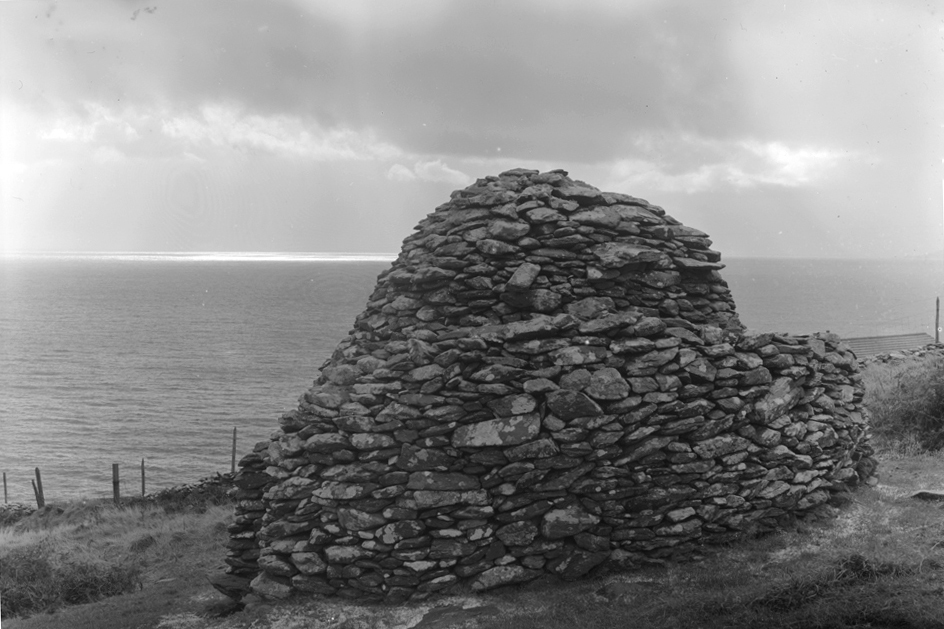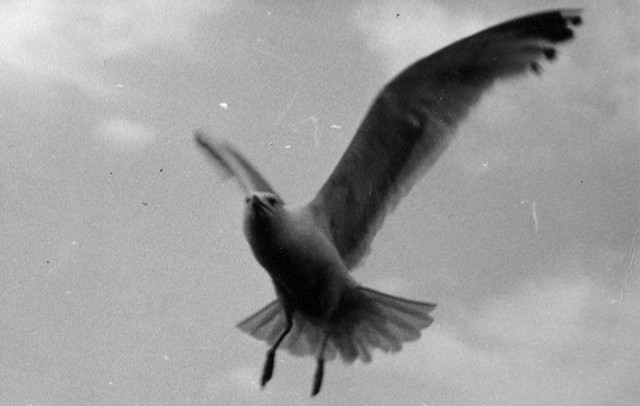Across A Painted Sea: Cian Quayle

Visiting Cian Quayle’s retrospective Points Of Departure at the Grosvenor Museum, Stephen Clarke finds a photographer enamoured with the call of the sea…
The coastline delineates the familiar from the unknown; possessing a distinct shape an island’s identity is defined as separate from the boundless sea. Raised on the Isle of Man, the artist Cian Quayle is conscious of the relationship between place and identity. In a current retrospective of Quayle’s work at Chester’s Grosvenor Museum, five early paintings from 1991 provide the ‘points of departure’ of the exhibition’s title. From the anchorage of home, the artist looked outward to register the view of the Irish Sea. The physical nature of paint traces the turbulent character of the pictured sea, the element of water leaving its mark on paper. These paintings are displayed next to prints that tie the artist to the land. Two inkless, embossed prints reveal the faint ghost of a landscape that has been impressed into the once moist paper, whilst two larger black-ink lithographs act as the artist’s compass, referencing the seafaring culture and Celtic origins of the Manx people. The island is a place that the artist leaves behind, yet its imprint defines him.
Both a barrier and a means of travel, the ever-changing sea is difficult to chart. Quayle has photographed from the ferry as he has travelled from, and returned to, the island. The large lightbox image Ferry at Sea (2009) presents a cinematic picturing of the crossing. Journey is paired with destination as the photograph Pier Head Landing Stage, Liverpool (2008) comes into view. Quayle’s work is accompanied by images drawn from his own archive and the Grosvenor Museum’s collection: these companions help the artist to navigate. An etching by George Cuitt of the Church of Our Lady & St Nicholas (1816) opposite Liverpool’s Pier Head, and a painting owned by the artist’s great-grandfather, serve as coordinates. Quayle’s practice is transitional, moving between graphic processes and disparate but connected subjects. The meaning of objects, such as Sea-mine (2004), is unfixed, in this case shifting from maritime menace to seaside charity collection box.

A collected archive of photographic material incorporating family snapshots, found photographs, postcards, and the artist’s own photographs, are the flotsam that represent Quayle’s travels. A display case in the gallery presents some of these items: a copy of Anthony Burgess’s A Clockwork Orange (1962) sits alongside Quayle’s photograph of London’s Thamesmead Estate, the location for Stanley Kubrick’s film version of Burgess’s book. Titled Inventory for a Reverse Journey, this collection of material is central to Quayle’s practice. The retracing of the journey from destination to starting point leads the artist back to the Isle of Man. Included in the gallery display case is the catalogue for Return Ticket (2003), an installation by the artist of 20 photographs along the boundary wall of Derby Castle Depot in Douglas, Quayle’s home town. The installation was positioned next to the tramline of the Manx Electric Railway, where passengers travelled backwards and forwards in time and space in the same manner as Quayle in his viewing of his collected material.
Quayle’s travels go beyond Liverpool and London. Material collected from other locales also finds a place in the inventory. A basket-woven object discovered by Quayle when he was in Barcelona becomes a repeated motif. On one wall of this exhibition the comparison between the shape and construction of the upturned basket, and the beehive-like dry-stone clochán huts of southwest Ireland, is made clear. The basket image is a large photocopy, an intermediary process between printmaking and photographic print. Quayle’s photograph of the clochán hut has been produced as a silver-gelatin print, a nearly redundant process. Uncertainty veils both basket and hut as their exact purpose is unknown. Drawn into dialogue with each other and the larger collection, such as the spherical sea-mine, a mythos is translated. Transcribed through different modes of representation, images and objects have alchemical resonance.
Flying higher than other images on the gallery wall is a lithograph made from a found black and white photograph of a seagull in flight (above). Traversing the seas these birds accompany sailors on their voyages and hover around the coastline. The albatross, famed for its ability to travel long distances across the southern ocean, leads the Ancient Mariner of Samuel Taylor Coleridge’s poem, to a cursed existence between life and death. This indeterminate state is the nature of journeying. Quayle’s digital video A Beautiful Pea-green Boat, River Dee, Chester (2009) shows a small boat moving backwards and forwards in the whirlpool currents of the river. As in Coleridge’s narrative, it is ‘As idle as a painted ship / Upon a painted ocean’. The boat frustratingly enacts a journeying without destination. Quayle has left the island and now circumnavigates the coastline that defines the place left behind. Stored memories provide coordinates that shift with repeated visits. Images are as fluid as the water that gives paint, print, and chemical photographic emulsions their stain. The mariner and the artist tell tales of home and elsewhere to those on the quay.
Stephen Clarke is an artist, writer, and lecturer based in the North West
See Cian Quayle: Points of Departure until 18 January 2015 at the Grosvenor Museum, Chester. Galleries open Mon-Sat 10.30am-5pm and Sunday 1-4pm, admission free
Curated by Peter Boughton, Keeper of Art at the Grosvenor Museum, Chester. Dr Cian Quayle is Programme Leader of BA Photography at the University of Chester
Cian Quayle’s book, Return Ticket, is available for purchase in the Museum shop
Images: main: Ferry at Sea (2009). Lightbox & Duratran. Top: Clochán hut, Dingle Peninsula, Ireland (2013). Gelatin-silver print. Centre: Seagull in flight (2000). Lithograph from found black and white photograph (Majestic Hotel Archive). All courtesy Cian Quayle
Like this? You may also like An Introduction To Psychogeography by Maisie Ridgeway





